This Acebeam Rider RX was provided by Acebeam for review. The Rider RX is available from Acebeam's Amazon store. Those are both affiliate links. Coupon code "ZW10" is good for a 10% discount on certain products at Acebeam.com.
Overview
The Acebeam Rider RX is a 14500/AA flashlight with a bolt-action fidget mechanism and a high-CRI Nichia 219F LED. I typically evaluate flashlights purely as tools, but everyday carry gear can also be toys, decorations, and collectables. The Rider RX offers some of each.
As a tool, this light is pretty good. The 219F might as well be a 219C; efficiency, tint, and color rendering are all very similar, which is to say decent for an EDC light. The forward-clicky mechanical tailswitch makes changing modes while the light is on more effort than most. The fidget mechanism and clip add weight and bulk, but not a problematic amount for most users. Making the Rider RX a toy does not stop it from being a good tool.
Both AA and 14500 have good, but different mode spacing as well as effective low-voltage protection. For AA, alkaline, NiMH rechargeable, or lithium disposable can be used, with NiMH being recommended for best performance. With 14500 Li-ion, both protected and unprotected cells can be used safely, but a button top is required. My biggest complaint is that output isn't regulated on 14500, and decreases as the battery drains.
Whether the Rider RX is suitable as a toy, decoration, or collectable is entirely subjective. I don't find the fidget action especially entertaining or satisfying, but I've read others say they do. I do find the appearance attractive, and six options for colors and materials for the outer sleeve provides a reason some buyers may be inclined to own more than one.
The Rider RX is conditionally recommended. The condition is that the buyer finds value in one of its non-tool aspects.
Specifications
| Spec | - |
|---|---|
| Battery | 1x14500 / 1xAA |
| LED | Nichia 219F |
| Color temperature | 5299K |
| Color rendering index | 90.6 |
| Max output (14500 battery) | 619lm |
| Max throw (14500 battery) | 92m |
| Max output (AA battery) | 216lm |
| Max throw (AA battery) | 51m |
| Max sustainable output | 81lm |
| Max output at 50% battery | 430lm |
| Best efficiency | 97 lm/W |
| Candela per lumen | 3.06 |
| Length | 96mm |
| Head diameter | 19mm |
| Weight | 61g |
| Weight with battery | 82g |
| Charging | None (Included battery has USB-C) |
| Low Voltage Protection (LVP) | Yes, 2.6V (Li-ion) |
| Lockout | None |
| Approximate price | $50 |
| Rating | ★★★☆☆ (conditionally recommended) |
Highlights
- High CRI
- Multiple color/material options
- Good support for different battery chemistries.
- Several attractive color/material options are offered for the outer sleeve
Lowlights
- Sub-lumen mode is only available with AA
- Output is unregulated with 14500
- Flat-top cells do not make contact
- Not very efficient
Details and technical analysis
Versions
The Rider RX is offered in aluminum with a steel outer tube in silver, grey, rainbow, and blue. It is also offered with a titanium outer tube with a bead blasted finish and an aluminum outer tube with black anodization. This is the steel, silver version.
Accessories
The Rider RX includes a 14500 battery with USB-C charging, USB A-C cable, lanyard, and spare O-rings.
Modes and user interface
The user interface is a forward-clicky tailswitch with off-time memory.
That means a half-press turns on the light momentarily and a full-press locks it on until fully pressed and released to turn it off. Off-time memory means turning the light off for a short time (half a second or so) and turning it back on will change modes, but it will return to the same mode if turned back on after a longer time.
There is no way to lock out the light completely, but extending the head from the barrel shields the switch, making it hard to press accidentally.
Output, runtime, and efficiency
14500 battery
| Mode | Advertised Lumens | Estimated Lumens | Estimated throw (FL1 meters) |
|---|---|---|---|
| Ultra-Low | 7 | 1 | - |
| Low | 70 | 61 | 27 |
| Mid | 280 | 316 | 62 |
| High | 650 | 691 | 92 |
| Mode | Estimated lumens | Time to 80% | Time to 50% | Time to 10% | Efficiency (lm/W) |
|---|---|---|---|---|---|
| Low | 61 | 72 minutes | 194 minutes | 820 minutes | 97 |
| Mid | 316 | 25 | 77 | 77 | 85 |
| High | 691 | 2 | 16 | 50 | 83 |
AA battery
| Mode | Advertised Lumens | Estimated Lumens | Estimated throw (FL1 meters) |
|---|---|---|---|
| Ultra-Low | 0.5 | - | - |
| Low | 5 | 3 | - |
| Mid | 80 | 81 | 32 |
| High | 200 | 216 | 51 |
| Mode | Estimated lumens | Time to 80% | Time to 50% | Time to 10% | Efficiency (lm/W) |
|---|---|---|---|---|---|
| Mid | 81 | 122 minutes | 122 minutes | 128 minutes | 75 |
| High | 216 | 7 minutes | 7 minutes | 126 minutes | 86 |
Light quality
Reading taken from the center spot diffused with DC Fix diffusion film using an X-rite i1Pro spectrophotometer on Mid mode with a 14500 battery.
| Color Temperature | Tint Duv | CRI | CRI R9 (deep red) | CRI R12 (deep blue) |
|---|---|---|---|---|
| 5299K | 0.001472 (slightly green) | 90.6 | 62.0 | 77.4 |
Beamshots
I'm comparing the Zebralight SC64c LE for reference. That light is not a direct competitor to the Rider RX, as it's considerably more expensive and uses a larger battery. It is, however a staple in my reviews.
Rider RX vs Zebralight SC64c LE
AA, 14500, SC64c LE
Batteries and charging
Both 14500 Li-ion and AA NiMH batteries are well-supported. AA Alkaline can be used in an emergency with reduced runtimes in higher modes. Only button-top 14500s make contact, but there's low voltage protection for both Li-ion and NiMH so use of unprotected cells is safe.
The included 14500 battery has a competitive capacity of 950 mAh and charges in about 3 hours from a USB-A -> USB-C connection. It does not comply with the USB-C standard and cannot charge from a USB-C -> USB-C connection, including many popular smartphone power supplies.
Size and ergonomics
While not a large light, the Rider RX is longer than most of its immediate competition. It's comfortable enough to carry and use, though I'd like some more texture in wet conditions or when wearing gloves.
Zebralight SC64c LE, Skilhunt M150, Olight i5T, Acebeam Rider RX, Skilhunt E2A, Thrunite T10 II
I found the fidget action a little awkward to use, which led to an inadvertant drop test from higher than the rated 1 meter onto concrete. The lens took a little damage, but the light continues to function.
Modification potential
This is not an easy light to open, though I've read some people have managed to disassemble the head. Once done, the usual array of 3535 size LEDs such as the Nichia 519A and Luminus SST-20 can be used.








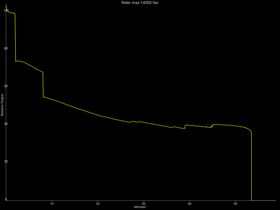
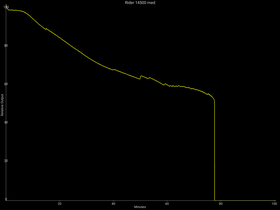
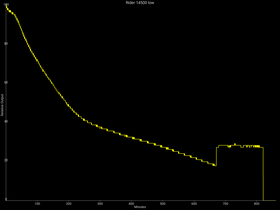
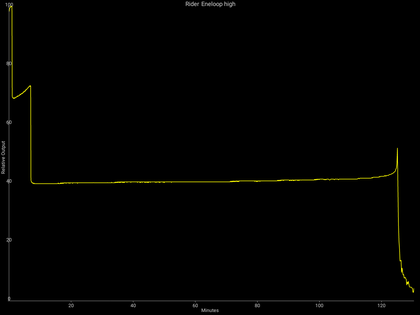
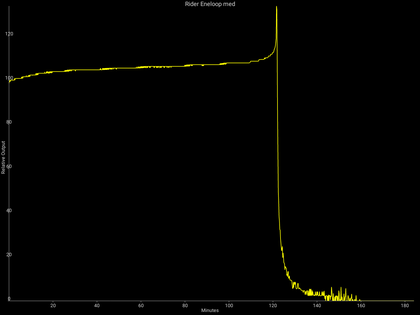











Comments
You can use your Mastodon account to reply to this
Reply
Loading...